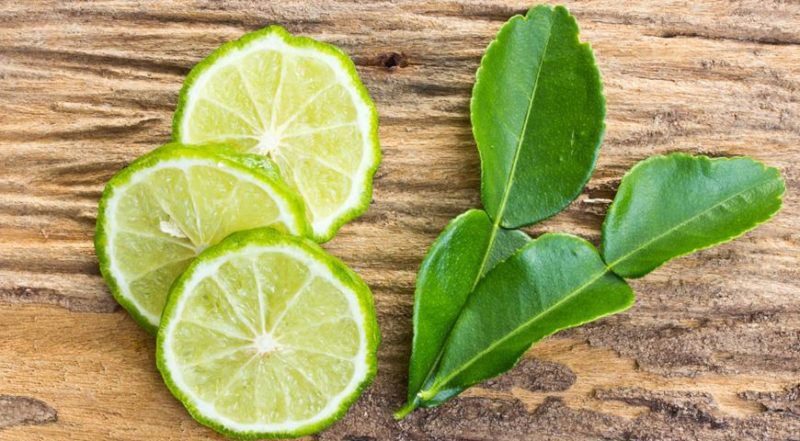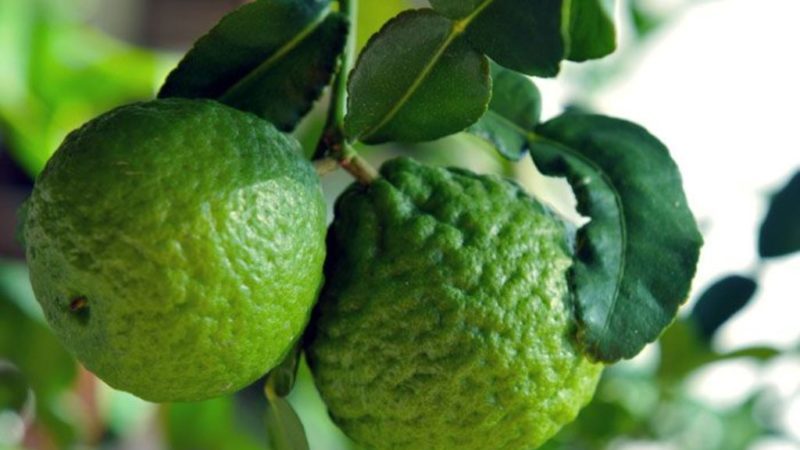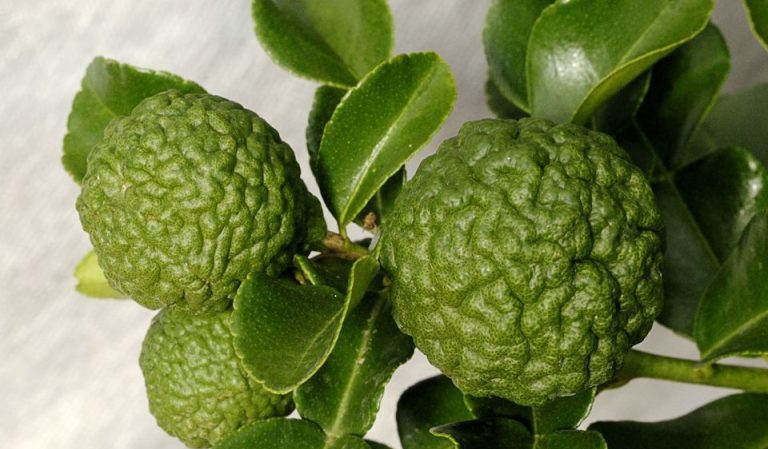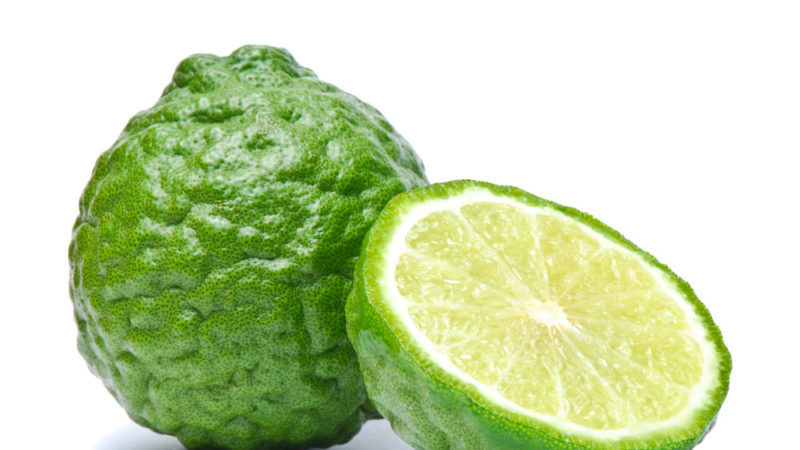Kaffir lime - what is this plant
Citrus fruits are consistently popular with indoor plant lovers. Even in a flower pot, they are able to bloom and bear fruit, and the fruits that grow on them are quite suitable for human consumption. And orange, tangerine and lemon are not the only trees suitable for home cultivation.
Among the most unusual representatives of homemade citrus fruits is the kaffir lime. It has interestingly shaped double leaves that have such a rich aroma that they are used in Asian countries as a seasoning. Its pimply fruits are no less original. Lima care is not much different from the rules for growing other plants from this family. What is kafir lime and how to grow it on your windowsill - read on.
The content of the article
What is Kaffir Lime

Despite the name, kaffir lime is not real lime from a botanical point of view. The plant belongs to another subgenus - papeda, and kaffir lime is just one of its names.
I'll hit the black-leaved one called differently. The list contains the most common names:
- kaffir (kefir, kafir) lime;
- maracut;
- kaffir lime;
- papeda hedgehog (official scientific name);
- Lima;
- Thai lime;
- kaffir lime;
- makrut lime.
A native plant from India. It is most actively used in Asian countries and Africa.
Botanical description
Kaffir lime is a tree up to 2 m high. At home, its height rarely reaches 1 m. The crown is spreading, the branches are covered with needles.
The leaves are double, shaped like an 8 or hourglass. They are thick and juicy, deep green, glossy. They have a rich aroma in which notes of citrus and bergamot intersect.
It is interesting! Kaffir lime leaves are used as a spice fresh, frozen and dried in Asian countries.
The fruits are small, round in shape. The crust is very lumpy, dark green. The pulp is not too juicy. It tastes tart and sour. The fruits are rarely eaten, mainly their zest is used. The fruit is also used in cosmetology.
The flowers at the inflorescence are white or cream. Outside, they have darker spots. When blooming, a subtle sweetish aroma emanates from the tree.
Planting lime at home

Kafir lime is grown in a generative and vegetative way. In the first case, seeds are used, and in the second, cuttings.
When sowing seeds, it will take a long time to wait for the first fruiting (5-7 years), but the plants will turn out to be more hardy and neat. Such trees have a higher immunity, they are able to withstand slight cold snaps.
If the lima is grown using the cuttings method, then the first fruiting is expected for 3-4 g. However, in this case, the kafir lime will be less resistant to diseases and mistakes in care,
Advice! To get all the benefits of the vegetative and generative way, with the rootstock of kaffir lime, grown from seed graft a branch of a fruiting tree.
In both cases, the soil is prepared in advance. For this, sand, humus and garden soil are mixed in equal proportions. Another option is to buy a special mixture for citrus fruits or a universal soil mixture (in this case, you will have to take 1 part of river sand for 2 parts of soil).
Be sure to use drainage. It will prevent moisture stagnation. Expanded clay, crushed brick, broken ceramics are used as drainage. The soil and drainage are disinfected.To do this, it is watered with a dark pink solution of potassium permanganate or calcined in the oven.
For sowing seeds, use a common, shallow container. Better if these are containers with a transparent plastic lid.
Cuttings are planted in cups with a diameter of 5-6 cm. Seed shoots with 2 true leaves dive into the same containers.
Important. There must be drain holes at the bottom of the containers. The pots are disinfected by soaking in boiling water or a dark pink solution of potassium permanganate.
Seed method
Kaffir lime seeds are sold in specialized flower shops. They are extremely rare on supermarket shelves.
Planting material must be properly prepared. To do this, it:
- Rinse and soak in water. The specimens that have floated to the surface are considered unsuitable for planting.
- Sort out. Remove damaged, thin, crooked seeds, as well as seeds with spots and other signs of disease.
- Soak in a light pink solution of potassium permanganate for an hour. Such disinfection will reduce the risks of plant disease.
- Soak for 12-24 in a solution of a growth stimulant ("Solution"). This will speed up the germination of the planting material.
A layer of drainage and soil is poured at the bottom of the container for sowing seeds. The soil is moistened abundantly. Seeds are planted in it, deepening by 1.5 cm. The crops are covered with a film or a lid made of transparent plastic and placed in a place with a temperature of 24-26 ° C.
The soil is moistened and ventilated daily for 10-15 minutes. When shoots appear, the duration of airing is gradually increased, and the greenhouse is dismantled.
Seedlings are placed on the windowsill... They are watered daily from a spray bottle with settled water at room temperature so that moisture gets on the leaves.
After the appearance of 2-3 leaves, the seedlings are transplanted into individual pots. In this case, the root collar is not buried.
Cutting method
Before propagating the kaffir lime by the cuttings method, choose a suitable mother plant. It must be absolutely healthy and has already given fruit several times.
Further algorithm of actions:
- From the edge of the one-year-old branch, 8-10 cm recede and the measured part is cut off. 2-3 live buds should remain on it. The place of the cut on the tree is covered with garden pitch.
- The lower leaves are removed from the cutting. Some citrus growers recommend removing small leaves at the top of the shoot, but this is not necessary.
- The shoot is soaked for 20 minutes in a light pink solution of potassium permanganate. Then the place of its cut is placed in a root formation stimulator ("Kornevin") for 2 days.
- Kaffir lime cuttings are rooted in a fertile mixture or sand. Both methods give equally consistent results.
- A drainage layer must be poured onto the bottom of the container. The rest of the volume is filled with soil, which is watered abundantly.
- The stalk is stuck into the soil with the cut down so that it can stand without support. It is sprayed from a spray bottle with warm water, covered with a bag or the top of a cut bottle, and removed to a warm place before rooting.
- Every day the seedling is watered, sprayed and ventilated. When it takes root, the film is removed, first teaching Kffir-lime to the conditions in the apartment, increasing the duration of airing every day.
The fact that the seedling has taken root will be evidenced by awakened buds, from which shoots will begin to appear. If the cutting has been planted in sand, it is immediately transplanted into a pot with nutrient soil. If the branch is rooted in fertile soil, then you can wait until the roots fill the entire container.
Plant care

Growing kaffir lime is not difficult. This tree is no more whimsical than other citrus fruits. With regular and proper care, it will not hurt and will give a bountiful harvest.
Conditions for growth
To prevent kaffir lime from getting sick, it is important to provide it with optimal conditions for growth. The main requirements are presented in the list:
- Temperature. The optimum temperature for growing kaffir lime is + 19 ... + 22 ° С.During the vegetative period, the plant is able to grow in the temperature range from +16 to +35 ° С. Particular attention is paid to the indicators on the thermometer during the flowering period. At temperatures above +22 ° C, the tree often drops flowers. In winter, it is recommended to remove the pot in a room with temperatures ranging from + 10 ° C to + 12 ° C.
- Humidity. Kafir lime requires high humidity. In the warm season, in order to ensure optimal conditions, it is sprayed with water at room temperature from a spray bottle 1-2 times a day. In winter, if there is a heating device in the room where citrus is grown, use air humidifiers, containers with water or a damp cloth placed on the battery.
- Lighting. The tree will feel most comfortable on the west or east window. On the southern windowsills, from 11 am to 4 pm, the kafir-lime will have to be removed to a shaded place. In winter, the plant is in a state of sleep, so additional lighting is not necessary.
Some citrus growers are not able to provide a lower temperature for the kaffir lime in winter, or they do not do this on purpose so that the plant develops faster. In this case, you will have to use fluorescent lamps, lengthening the daylight hours to 12 hours.
Important! Citruses that were dormant in winter are more hardy, bloom and bear fruit more abundantly than those that were warm during the cold season.
Care rules

It is required to take care of the kafir lime regularly, otherwise it will die or will not bear fruit. However, daily manipulations do not take long.
How to care for kaffir lime:
- Watering. In the warm season, every 1-2 days, kafir lime is watered with warm, settled water. In winter, it is enough to moisten the soil once a week. Water the plant early in the morning or in the evening when the sun is not active. Otherwise, burns will appear on the greenery.
- Loosening. At least once a week, the top layer of the soil is loosened. For this, it is convenient to use an ordinary villa. Loosening allows you to destroy the earth crust, restore air exchange, and prevent moisture stagnation.
- Transfer. For the first 3 years, kafir lime is transplanted annually. The transshipment method is used. For this, the kffir lime is taken out of the pot along with a lump of earth. In the lower part, drainage is removed, and the upper one is 1-2 cm of soil. A drainage layer is poured into a larger container and a tree is placed along with a lump of earth. The missing volume of soil is filled up. Citrus is poured over with warm water.
- Transplants. After the first fruiting, the transshipment is stopped. Kafir lime is transplanted once every 2-3 years. In this case, 2/3 of the earthen coma is removed from the tree taken out of the pot. All dry and rotten roots are removed, it is recommended to cut the root system by 1/3. After that, the tree is transplanted into a pot with new soil and drainage. When the kafir lime reaches the desired size, the transplants are stopped. It will be enough to replace the topsoil once a year.
- Fruiting and fruiting. If the tree has bloomed already 1 or 2 g after planting, all flowers are cut off so that the kaffir lime does not waste energy on them. Flowers are left only 3 years after planting. In the first fruiting, I remove most of the ovaries, leaving only 2-3 pieces on the tree.
- Cleaning. Every week, the leaves of the kaffir lime are wiped with a damp cloth. Every month he is washed under the shower.
- Top dressing. Thai limes are fed every 1-2 weeks. They use both special fertilizers for citrus fruits and homemade remedies (herbal infusions, tea, coffee, manure, humus, etc.). It is recommended to alternate organic and mineral feedings.
Shaping and pruning
For kaffir lime to bear fruit and look aesthetically pleasing, it must be shaped. In addition, this procedure improves air circulation in the crown, which significantly reduces the risk of developing diseases.
Crown formation:
- When the tree reaches a height of 20-35 cm, its top is pruned.
This stimulates the formation of new shoots. - Shoots of the first order are cut to a length of 15-20 cm.Buds must be left on the branches.
- In this way, they do with all shoots up to order 5.
Lime is formed in early spring or autumn. At the same time, sanitary pruning is carried out, in which all dry, damaged and diseased branches are removed.
Important! Places of cuts on a tree are covered with garden varnish.
Diseases and pests

At home, kafir lime is rarely affected by pests, but sometimes it happens. The following insects appear most often:
- Aphid. Small black or light green beetles cling to young shoots and plant leavesfeeding on its juice. This causes the branches and greenery to dry out. To save citrus, they wash it under the shower, after which every week for a month they are sprayed with a solution prepared from 0.5 bar of laundry soap and 5 liters of water.
- Spider mite. Small, usually red, mites form a web on the inside of the leaf blades. They feed on plant sap... To get rid of the pest, kafir lime is washed under the shower and sprayed with a decoction of bitter herbs or soap-garlic infusion.
- Shields. The larvae of scale insects settle on the branches and veins of the leaves of the plant, covered with a strong shell. To get rid of the problem, kaffir lime is sprayed with a product made from 50 ml of kerosene, 0.5 bar of soap and 5 liters of water.
Sometimes lima are affected by diseases. At home, fungal diseases most often occur: gommosis, root rot, soot fungus.
To save the plant, cut off all affected parts. Places of cuts are treated with garden pitch. The plant is sprayed with a biological product (Fitosporin) or a fungicide (Epin).
note! The main reason for the development of diseases and damage by pests of kaffir lime is a violation of the rules of care and planting.
Conclusion
Kafir lime is one of the most unusual citrus plants. Its fragrant double leaves have found their way into culinary, cosmetology and even medicine. The tree is also grown at home.
Growing papeda blackberry at home is no more difficult than any other citrus. The main thing is to follow the basic rules of care, do not forget to feed and water the plant.
Thank you very valuable information on the incredible citrus. Renata